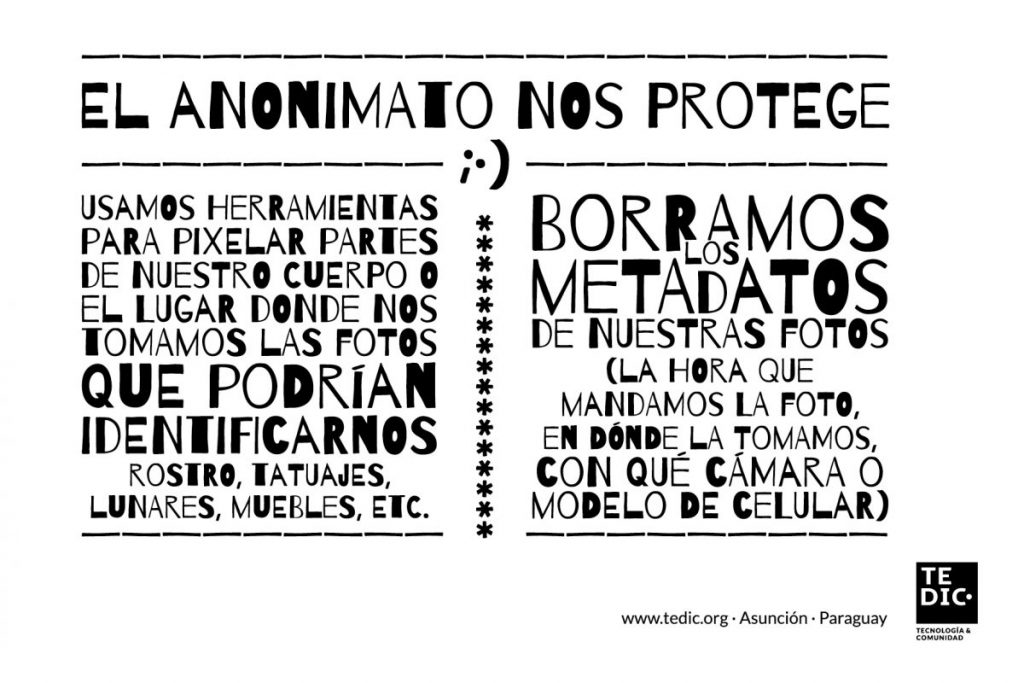Sexting – Self-care on the Internet #SendNudes
Sexting Is Both A Pleasant And An Empowering Practice

What is sexting?
When talking about sexting, we probably think about it as taking a naked “selfie”, but it is much more than that. It can also be any kind of provocative message sent from someone’s phone or computer, such as a photo, an audio recording or a video. This type of activity is usually meant to be a private matter, but sometimes accidents happen and something that was thought for the eyes of a certain person (or certain people), ends up being shared with third parties who were not part of the original conversation.
Sexting is part of our sexual health, which is a fundamental right, more precisely a sexual and reproductive right, which affects the individual, interpersonal and social well-being of each person. Therefore, the challenge is to demand that our authorities respect and safeguard this right.
Sexting is a form of sexual freedom, which contributes to our self-determination in the field of sexuality, with no other limitation than the respect for other people’s freedom. This sexual freedom is expanded by using one’s own body at will, following any chosen sexual orientation at any given time or making and accepting proposals that suit us, as well as rejecting unwanted ones.
According to WHO, regarding sexual health, a positive and respectful approach towards sexuality and sexual relations is necessary, as well as having the possibility of obtaining pleasure and enjoying safe sexual experiences, free of coercion, discrimination and violence. For sexual health to be achieved and maintained, the sexual rights of all people must be respected, protected and fulfilled.
Sexting also means exercising the right to freedom of expression and privacy, in addition to being considered a pleasant act of resistance against racism, sexism, machismo, conservatism and heteronormativity.
Is sexting okay? Isn’t it a bad thing?
The key to sharing intimate images is consent. However, as the site acoso.online points out, “even if you consented to capture the images, this is not equivalent to consent its storage nor the distribution of such material«. So sexting is only legal when it involves consent. That means that nude videos or photos taken, stored and/or distributed without the knowledge of the person are illegal. Constantly harassing someone or otherwise pressuring them into sending a nude photo or video is also illegal.
Sexting generally occurs between people who freely agree to it, however, there are situations where one person manipulates the other into sending them a sexy snap. If you feel pressured to sext, you may be suffering harassment or extortion. You should never be pressured into engaging in any type of sexual activity that you don’t feel comfortable with.
Sexting does not involve risks by itself, but in practice it can become problematic, leading to many complicated situations: violation of our rights to privacy or freedom of expression, violation of our sexual rights through extortion (misnamed ‘revenge porn’) or distribution of intimate images without consent, as well as the publication of personal data without authorization. There may also be stigmatization of the woman’s body: the tendency is to vilify, denigrate and blame the woman as the sole responsible for events that could torment her for the rest of her life. All of these are forms of violence that limit and put at risk sexual enjoyment, blaming the victim for the potential negative consequences of sexting.
In other words, the problem is not sexting, but the sexist behavior of those who spread images, messages and videos without consent, ignoring the responsibility assumed in the prior agreement by the people who perform sexting, and the rights of the other person.
Three aspects of sexting: how you sext, where you sext and with whom you sext
The key to sharing intimate images is prior consent and agreement. Therefore, people who sext should at the same time take care of themselves and assume the responsibility of taking care of the other person. Make sure that the three stages of sexting are clear in the agreement: the registration of the image (or text, or video), its storage and its distribution.

Tip 1: We have absolute control over every message we send, be it a sexy text or an intimate image or video. They may include our face, our full body or particular parts of the body, and these may be displayed in a covered, explicit or artistic way. Imagination is in our power.
Tip 2: Let’s choose our tools well. It is not recommended to sext through unknown or unsafe mobile apps which do not include a deletion option, and/or don’t feature anonymization or encryption. For a free and safe sexting, carefully select a tool that offers the best standards for the protection of your rights.
Tip 3: Trust is central, but its duration may vary for each given relationship, and it is important to be aware of the risks that this can entail. Depending on the person, sexting can be done with people we know well or with people we know not-so-well (contacts from Facebook, Twitter, Tinder or Grindr). Therefore, it is important to be aware of the correct handling of identities and anonymity in sexting in order to reduce the risk of violence on the Internet.
What to do if images are nonconsensually disseminated?

First of all, we must bear in mind that sexting has shared responsibility as one of its main characteristics. Therefore, on top of sexting securely, we should not violate later the prior agreements regarding its nonconsensual storage or dissemination.
This entails legal consequences that may include complaints of harassment (private criminal action), violation of privacy, personal data, transfer of image (intellectual property), gender violence, among others. If it happens on the Internet, try to report the case through the contact lines of the website or social network. If you are still concerned, we recommend that you speak to a trusted person and/or the police.
Secondly, the cycle of sexual violence should not be fueled. When facing this kind of event, the victim must be supported, the person who disseminates the images must be reported and, above all, the images must not be reproduced through other channels or networks. The culprit is not the victim, but the one who broke the trust agreement and produced that act of sexual violence.
Diamonds are forever, and so are your sexy pics. What to do to reduce the risks.
There are technological tools that can help you protect yourself, so it’s important to understand the legal shields that each app has to defend your digital rights.
Tip 1: Anonymize

Anonymity is a right that helps guarantee other fundamental rights, such as protecting our privacy, expressing ourselves, meeting with others, seeking information, seeking help and, of course, sexting.
1.1 Edit: Use stickers to cover or cut out signs that can help identify you, such as tattoos, a birthmark, or even your face. This will later allow you to deny that it is you in the picture, in the event that someone violates your right to privacy.
1.2 Delete the metadata (data about other data): Metadata is all the data that complements and contextualizes a computer file and could eventually help identify you. In the case of an image, the metadata can be geolocation, cell phone model used, date and time, etc. To access this information, check the image properties or insert your pictures on the website http://metapicz.com.
To delete the metadata of cell phone images, you can use ObscuraCam (developed by The Guardian Project), which allows you to remove metadata and also to blur parts of the picture. You may also use Metanull or Send Reduced to remove metadata. Be sure to follow the anonymization tips we mentioned before.
Something important to keep in mind when pictures are downloaded from social networks (such as Facebook, Twitter or Instagram), is that these networks usually delete the original metadata. However, this metadata may be stored on the servers of these companies.
1.3 Clear traces when browsing: To avoid leaving traces, use browsers in incognito (or private) mode. This prevents both browsing data (history, cookies, searches, etc.) and passwords from being stored. So, if you forgot to log out of any web page or social network, don’t worry, nobody will be able to access it.
Keep in mind that browsing also shares information with Internet providers through the connection’s IP address. For example, you can see your current geolocation using the web tool https://whatismyipaddress.com.
1.4 Anonymize your IP: One step further could be anonymizing your IP address through the Tor browser or a VPN (Virtual Private Network1). There is also the possibility of using the ‘amnesic’ and incognito operating system called Tails.
Once you install any of these tools on your cell phone or computer, check that your Internet access no longer corresponds to your actual country. As mentioned above, you can use https://whatismyipaddress.com.
Tip 2: Encrypt Your Communications And Devices
- Always browse sites that use the secure Internet protocol ‘HTTPS’. This often looks like a tiny padlock on the left of the address bar.
- If you sell your phone, reset it to factory defaults to prevent people from accessing your files.
- Keeping your devices updated is very important, as it may fix vulnerabilities and prevent unwanted access.
- Encrypt your devices to prevent access to your sensitive data in the event of theft or loss.
- When eliminating images or videos, be sure to also eliminate backups. Some cell phones and apps create automatic backups, so it is advisable to check that they also disappear.
- Use apps that include end-to-end encryption. This means that the communication between two or more cell phones is encrypted in a way that no one else can access the information. It is as if they speak a language that no one else knows, not even the company that provides the service. Some apps that use end-to-end encryption are Signal, WhatsApp, Facebook messenger and Telegram (optional).
- Use Jitsi or WhatsApp for video sexting. Jitsi is a web platform that offers HTTPS encryption and allows users to create temporary rooms for voice and video chat, without the need to install anything on the computer or device.
- Avoid sending text messages or making phone calls, as all the information will be stored by your telephone service provider. Chat apps like Signal or Whatsapp also include point-to-point encryption in calls. There have been reports about cases where employees of telephone companies published conversations of couples in order to make fun of them.
- Use apps that allow you to have the highest level of control, such as the possibility of remotely deleting images, using the message fading function or receiving screen capture alerts. Some apps that include this are Signal, Telegram, Instagram and Whatsapp (in their more recent versions), with deletion permission up to 7 minutes after sending.
If you want to know more, check the presentation we made for a workshop on sexting:
Notas:
- Read our article on VPN (in Spanish): https://www.tedic.org/la-vpn-como-forma-de-libertad/

